(!)Due to
Microsoft's end of support for Internet Explorer 11 on 15/06/2022, this site does not support the recommended
environment.
Instead, please kindly use other browsers like Google Chrome, Microsoft Edge or Mozilla
Firefox.
- Notice of End of Sales for Economy Series Pneumatic Equipment Category. More details.
Detection Objectives and Sensor Types—Mechatronics Course for Mechanical Designers—The Role of Device in Machinery (Equipment)—“Detection”
What is Detection?
“Detection” refers to the process of activating a signal from a sensor when the
sensor perceives a specific type of information (such as the presence or absence of a
workpiece).
For example, an optical sensor detects the absence of a workpiece by detecting
that the light from the input reaches the receiver without being blocked by an obstacle on the
optical axis. If the sensor can’t detect the light at the receiver, an obstacle (the workpiece)
is present.
Detection objectives and sensor types
This article describes four objectives of the detection processes used for testing. These objectives are “detecting the presence or absence of a workpiece”, “detecting the position of a workpiece”, “detecting the level of a liquid”, and “detection done by safety light curtains”.
1. Detecting the presence or absence of a workpiece
Detecting the presence or absence of a workpiece is the most basic and typical detection
objective.
Typical items to be detected include wafers, glass substrates, metal objects and paper.
Special care is needed when detecting highly reflective items such as wafers, and transparent
items such as glass.
The main sensor types used to detect the presence or absence of workpieces are “proximity
sensors,” “micro photosensors” and “photoelectric sensors.”
| Proximity sensors | Micro photosensors | Photoelectric sensors | |
|---|---|---|---|
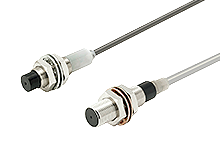
|
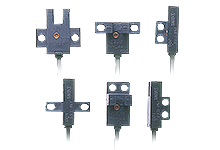
|
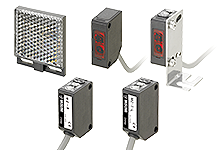
|
|
| Features |
|
|
|
| Uses | Detecting metal parts for machining or other workpieces mounted in jigs or tools | Checking the operation of stage sensors, moving parts, etc. | Detecting a wide range of different workpieces |
2. Detecting workpiece positions (seating, etc.)
Along with detecting the presence or absence of a workpiece, the sensors below can also determine whether the workpiece is in the right position (properly seated).
| Photoelectric sensors | Laser sensors | |
|---|---|---|
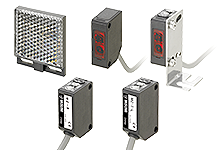
|
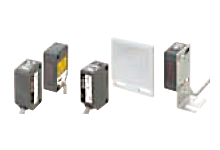
|
|
| Features |
|
|
| Uses | Detecting a wide range of different workpieces | Applications such as length measurement |
These sensors detect workpieces from the performance of the sensor itself.
But in some cases they can also achieve detection by operating a component within the seating
mechanism and detecting that component.
3. Liquid level detection
Liquid level detection is a common requirement when working with liquids.
The sensors below are used to detect liquid levels. Note that factors such as different
difficulty levels and accuracy requirements need to be considered when selecting the sensor to
use.
The use of individual sensor features may sometimes also require careful checks of individual
specifications and discussions with the manufacturer.
| Ultrasonic sensors | Photoelectric sensors | Float sensors | |
|---|---|---|---|
| Features |
|
|
|
4. Safety light curtains
Since safety is a key area of concern for machinery (equipment), operation safety measures are
studied carefully.
Safety light curtains are a typical safety measure.
Safety light curtains detect area encroachments by detecting objects cutting across any of
multiple optical axes.
They are installed in places where arms, fingers or other body parts entering the zone of
operating machinery (equipment) is deemed dangerous.
Since these safety-related sensors play such an important role in saving lives and preventing
injuries, the same sensor model may be listed in different categories